bachelor of arts '40
Glazer keeps focus on Bauhaus in her art, teaching, home
A person in love with art, design, teaching, and education, Jean Kendall Glazer educated generations of art teachers, artists, and designers, beginning with her first job teaching art at Salem High School after graduation from UO. Decades later, midway through her teaching career, her teaching excellence was recognized statewide when she was presented with the Oregon Art Educator of the Year award in 1988. She graduated from the UO in 1940 with a degree in art education.
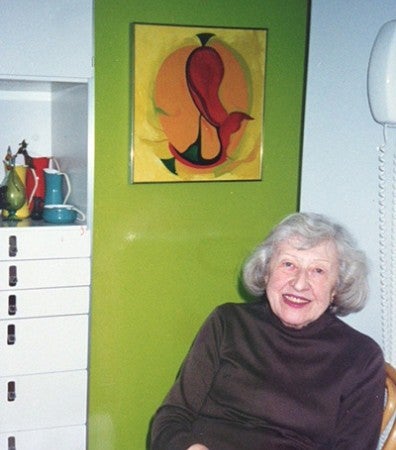
Above: Glazer sits below her painting of red peppers in her home. Photo by Ken O’Connell.
Glazer began a lifelong interest in the Bauhaus movement in 1941, when she attended a New Bauhaus special summer session at Mills College, California. World-renowned Bauhaus design educator László Moholy-Nagy, director of the Institute of Design (New Bauhaus) in Chicago and former teacher at the German Bauhaus, brought the Institute's entire faculty to Mills for the session. For Glazer, her immersion that summer in Bauhaus turned out to be a seminal experience.
"I was working with people who were all thinking beyond the present into the future. There was so much invention, creativity and experimentation," she says. Practitioners of Bauhaus were testing the limits of new materials and finding new ways of using familiar materials—such as inventing wood bedsprings during a time of metal shortages in WWII. "What I found exciting," said Glazer of Bauhaus, "was that attitude towards the world of possibility and inventiveness."
Moholy-Nagy encouraged her to apply to the Institute of Design, and she began her graduate work there in 1945, receiving her master’s in visual design in 1948. She studied with Moholy-Nagy as well as other international faculty including Austrian artist Marianne Willisch. In explaining her interest in the Bauhaus, Glazer wrote,
Never before were so many industrial tools and processes available to the artist and designer. The school that Glazer attended brought in economists, linguists, and industrial designers from major corporations to help the students understand the dynamics of the modern industrial revolution.
A note from the 2001 Faculty Emeritus Art Show at PSU said of Glazer:
What she discovered at the Institute and wanted to give to her students was a sensitivity towards design elements—light, space, color, form, texture and line—basic to all forms of art that affect people in profound ways. “If you can help people be creative, they feel confident and that they are making a contribution to the world,” Glazer says. "That's important for everyone from early childhood."
Glazer served for several years as assistant to Maude Kerns, a renowned UO alumnae and faculty member (The Maude Kerns Art Center was named in her honor).
"Maude was a major influence in my teaching career and in my life,” Glazer says. “Among the classes she taught were design and modern painting, which was called ‘representation’ because the painting department wouldn't permit her to teach a class called ‘painting.’ "
Glazer returned to UO to teach art education for many years, but most of her teaching career was spent at Portland State University, where she taught art education from 1955 into the 1980s.
Glazer was the force behind many of the successful artists, designers, and craftspeople in the Northwest. She was particularly important in UO alumnus and Professor Emeritus David Foster’s decision to meet Moholy-Nagy in Chicago and then attend the Institute of Design.
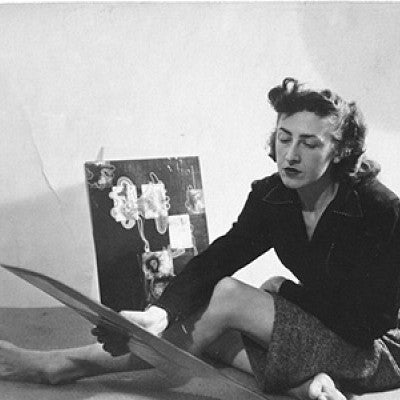
Jean Glazer with her paintings about 1940, when she was teaching at Salem High School. “I am not intimidated by anyone,” she once said. Photo courtesy Jean Glazer.
Foster had been a student of Glazer’s at Salem High School and later worked as a graduate assistant for her in the Department of Art Education at UO. Glazer introduced Foster to top Chicago designers Morton and Millie Goldsholl, who employed Foster part time while he attended the Institute of Design and then full time later.
One of Glazer’s students at PSU, Emily Young, remembered that she and Glazer “always talked about excellence in teaching art. She [often] told me that Moholy-Nagy and Maude Kerns were her greatest inspirations for teaching art—they were great artists but never forgot their responsibility as teachers. Jean thought Maude never received the credit for all the great advances she pursued at the U of O.”
Glazer was a rare individual who maintained a correspondence with many artists and designers during her career. She conducted extensive letter exchanges with A&AA’s Dean Ellis Lawrence and W. R. B. Willcox, the curricular head of architecture in A&AA. She was also a close friend of Kerns, who established what would become the UO Department of Art Education, where Glazer taught after Kerns retired.
Glazer’s own artwork was in painting with many media. “As a painter, I am an abstractionist in what I consider is a constructive way,” she says. “However, I feel that a good traditional background is essential to justify abstraction, that an artist must be able to paint representationally before being justified in very free, emotional painting.”
The 2001 PSU Faculty Emeritus Art Show catalog noted that:
In her own work Glazer is highly experimental. She works with mixed media, often using artificial negative prints of ordinary found objects and transforming them by magnification, focusing on sections, playing with reducing or eliminating recognition and then adding transparency overlays of texture and color. She also works with negatives created by the interactions of media mixtures, such as India ink on acetate, sometimes freeflow, sometimes airbrush. She then transforms and manipulates those negatives. The result may end up being the catalyst for an oil painting or watercolor. She has long been interested in photograms and cameraless photography.
She took her love for Bauhaus to its logical apex, designing a home for herself in the Bauhaus tradition in Portland, Oregon. In it she houses her remarkable collection of arts, crafts, and designer furniture by the famous artists and designers that she taught or studied with.
Glazer has traveled extensively, to Peru, Russia, Denmark, Finland, Guatemala, France, Spain, Italy, Ireland, and The Netherlands, and she participated in the sister city exchange with Sapporo, Japan. In all her travels she studied and collected arts and crafts of the cultures she encountered.
The College of the Arts at Portland State University established the Jean Kendall Glazer Endowed Scholarship in the PSU School of Art + Design, noting that Glazer “was responsible for establishing and maintaining the art education program from its inception until her retirement in 1987.” The scholarship supports art majors studying art education.
The scholarship embodies Glazer’s beliefs about art and education, in the best Bauhaus tradition. “I have a very strong conviction that it (education) can be the only possible route to world peace, international harmony, and individual peace and happiness,” she says.

Above: Glazer’s living room, which she designed mindful of the frequent gatherings she loved to have with students and friends. The room is filled with art by Northwest artists, many of them her students. The furniture is an eclectic “collection” from her family and Maude Kerns, and some in the Modernist Bauhaus tradition. Photo by Ken O’Connell.
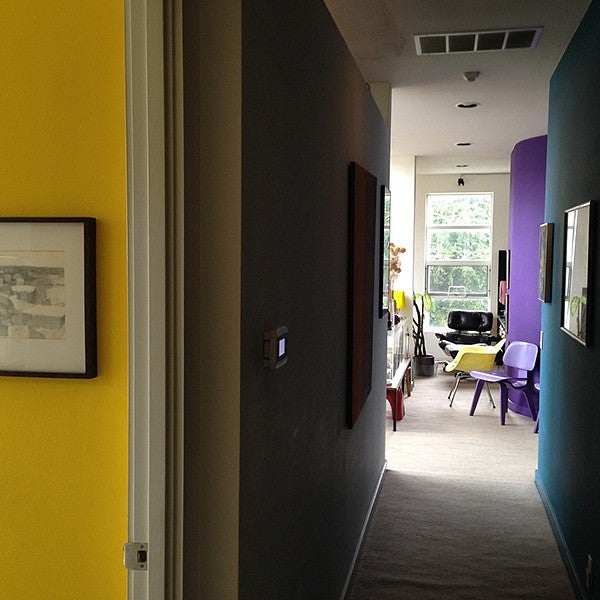
Above: Glazer’s house incorporates Modernist furniture, brilliant colors, and plenty of art. The solid intense wall colors give a powerful modern feel to this beautifully designed three story house. Photo by Ken O’Connell.
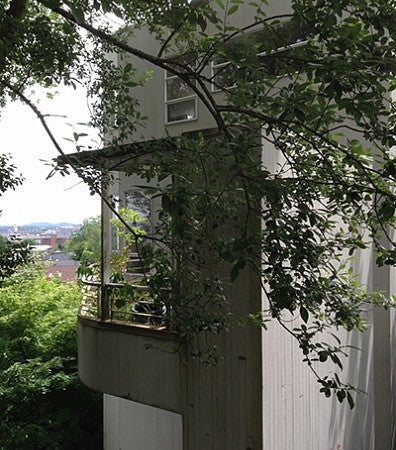
Above: The exterior of Glazer’s house, which she designed in the Bauhaus style in Portland. Photo by Ken O’Connell.
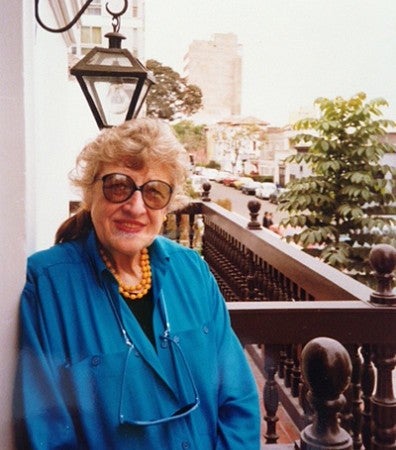
Above: Jean Glazer traveled extensively studying art and culture. She is pictured here in Peru. Photo courtesy Jean Kendall Glazer.
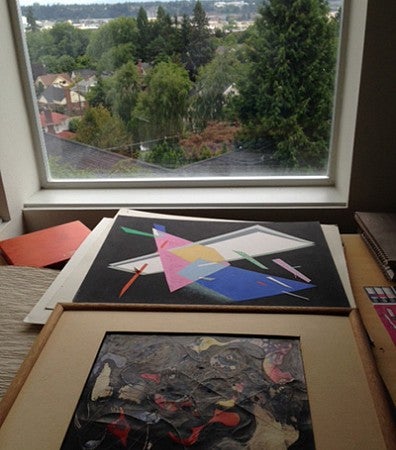
Above: Two of Glazer’s paintings, framed on the table by a window in her studio, show her use of various materials. Photo by Ken O’Connell.
